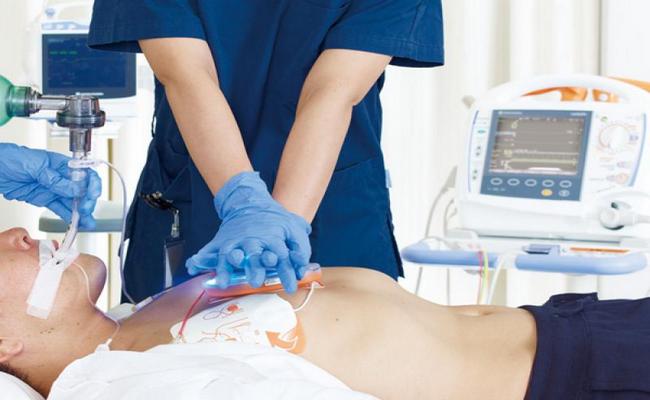Cardiopulmonary Resuscitation (CPR) Definition:
CPR stands for cardiopulmonary resuscitation. It is an emergency lifesaving procedure that is done when someone’s breathing or heartbeat has stopped. This may happen after an electric shock, heart attack, or drowning. This article will explain the various steps or procedure of providing cardiopulmonary resuscitation CPR followed in hospital.

Step by Step Cardiopulmonary Resuscitation (CPR) Procedure in Hospital:
There are three physical symptoms that indicate a need for CPR to be performed immediately and for emergency medical support to be called: unconsciousness, not breathing, and no pulse detected.
A. Compressions: Restore blood circulation
- Put the person on his or her back on a firm surface.
- Kneel next to the person’s neck and shoulders.
- Place the heel of one hand over the center of the person’s chest, between the nipples. Place your other hand on top of the first hand. Keep your elbows straight and position your shoulders directly above your hands.
- Use your upper body weight (not just your arms) as you push straight down on (compress) the chest at least 2 inches (approximately 5 centimeters). Push hard at a rate of about 100 compressions a minute.
- If you haven’t been trained in CPR, continue chest compressions until there are signs of movement or until emergency medical personnel take over. If you have been trained in CPR, go on to checking the airway and rescue breathing.
B. Airway: Clear the airway
- If you’re trained in CPR and you’ve performed 30 chest compressions, open the person’s airway using the head-tilt, chin-lift maneuver. Put your palm on the person’s forehead and gently tilt the head back. Then with the other hand, gently lift the chin forward to open the airway.
- Check for normal breathing, taking no more than five or 10 seconds. Look for chest motion, listen for normal breath sounds, and feel for the person’s breath on your cheek and ear. Gasping is not considered to be normal breathing. If the person isn’t breathing normally and you are trained in CPR, begin mouth-to-mouth breathing. If you believe the person is unconscious from a heart attack and you haven’t been trained in emergency procedures, skip mouth-to-mouth breathing and continue chest compressions.
C. Breathing: Breathe for the person
- Rescue breathing can be mouth-to-mouth breathing or mouth-to-nose breathing if the mouth is seriously injured or can’t be opened.
- With the airway open (using the head-tilt, chin-lift maneuver), pinch the nostrils shut for mouth-to-mouth breathing and cover the person’s mouth with yours, making a seal.
- Prepare to give two rescue breaths. Give the first rescue breath- and watch to see if the chest rises. If it does rise, give the second breath. If the chest doesn’t rise, repeat the head-tilt, chin-lift maneuver and then give the second breath. Thirty chest compressions followed by two rescue breaths is considered one cycle.
- Resume chest compressions to restore circulation.
- If the person has not begun moving after five cycles (about two minutes) and an automated external defibrillator (AED) is available, apply it and follow the prompts. Administer one shock, then resume CPR-starting with chest compressions for two more minutes before administering a second shock. If you’re not trained to use an AED, other emergency medical operator may be able to guide you in its use. If an AED isn’t available, go to step 5 below.
- Continue CPR until there are signs of movement or emergency medical personnel lasting one second take over.

Maria Khatun Mona is a Founder and Editor of Nursing Exercise Blog. She is a Nursing and Midwifery Expert. Currently she is working as a Registered Nurse at Evercare Hospital, Dhaka, Bangladesh. She has great passion in writing different articles on Nursing and Midwifery. Mail her at “maria.mona023@gmail.com”
